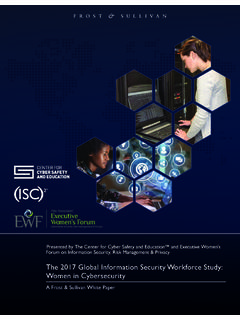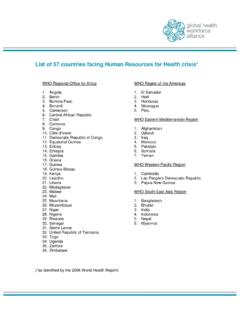Transcription of Determining Hospital Workforce Requirements: A …
1 210 Human Resources for Health Development Journal (HRDJ) Vol. 3 No. 3 September - December, 1999 Original ArticleDetermining Hospital Workforce Requirements: A Case StudySerpil Ozcan1, Peter Hornby2(1) World Bank Health Project, Ministry of Health, Ankara, Turkey and Centre forHealth Planning and Management, Keele University, England(2) Centre for Health Planning and Management, Keele University, EnglandAbstractThe difficulty of ensuring an adequate and appropriate distribution of health services, together with increasingfinancial pressures in the public sector, are forcing many countries to consider using more rigorous methods fordetermining staffing levels in the health facilities. The Workload Indicators of Staffing Need (WISN) method is onesuch method. It uses a form of activity analysis (activity standards), together with measures of utilisation andworkload to determine staffing requirements .
2 The method provides a vehicle for assessing localised staffing needsthat is believable and which at the same time is sharply different to historic methods. This paper describes experiencesin applying this method in hospitals in manpower is to be optimized. Other issues related to autonomy arealso discussed in varying words: WISN, activity standards, workload, Hospital staffing, countries, both in the developing anddeveloped world, are experiencing the burden ofincreasing demand for health services and,associated with this, increasing costs in healthcare provision. As with most countries, Turkey,with limitations on funding of its public healthservice, must seek to meet these demands withnew, more efficient and more radical approachesto health and health care provision. This mustinclude a more effective use of its critical resource is the health workforceitself, both because it consumes between 70%and 75% of the recurrent budget allocated tohealth and because it is the skills, capacity andcommitment of this resource that will be a majordeterminant of efficiency and effectiveness inthe delivery of health provision of health care is dependenton a complex array of social, political, economic,demographic and epidemiological factors.
3 Therequirements across the country for healthservices and the related staff who go with theseservices will vary and depend on variations inpopulation density, age, sex and mortality; wealthand education; geographical features; utilisationpatterns of health services; and the ease of accessto these staffing norms based solely onpopulation or institutional size do not adequatelytake into consideration these variations of needwithin a country. This necessarily creates realproblems in health service provision, not onlythrough under- or over-provision of health servicestaff but also through the inappropriate allocationof different cadres of the developing world there has beencontinued difficulty in ensuring an adequate andappropriate distribution of health service staff todeliver both preventive and curative healthservices equitably across a country. Thisserpil1120/1/32, 4:20 AM210211 Serpil Ozcan, Peter Hornby Determining Hospital Workforce requirements : A Case Studydifficulty has been compounded by increasingfinancial pressures on public sector finances;difficulties in providing adequate resources andfacilities to support the Workforce ; increasingpublic expectations of health care and the qualityof health care; and, finally, an emerging middleclass able to purchase private health care which,in many cases, is substantially superior to thecare available through the public sector health services are, as aconsequence, experiencing new pressures toimprove the quality, quantity and accessibilityof the services they provide, while at the sametime having to operate under tight financialconstraints.
4 Allied to these pressures is the needto change the roles that different cadres of staffdischarge, emerging in part from new views ofhealth professional roles, partly through achanging technology for health interventions andpartly through a requirement for greater skills inthe Workforce to meet the growing expectationof the meet these pressures, many governmentsare introducing radical changes, includingdecentralisation of responsibility for health careand, increasingly, promotion of the private have, at the same time, to ensureincreased value for the money they invest inpublic sector health services. This has led manycountries to look at ways of improving theefficiency and effectiveness of the services theyprovide. This inevitably leads to a closerexamination of the basis on which staff aredistributed throughout the health service and howthey can be used more efficiently and effectivelyin raising the health of the population as a significant development in this hasbeen increased attention to monitoringperformance and efficiency in the constituentorganisations of the health service(1).
5 There areincreased efforts to ensure staff are fully utilisedby introducing a new orientation to settingstaffing standards for individual new standards are intended to reflect boththe type and volume of work undertaken by aparticular the existing system in Turkey, staffingrequirements in health facilities are determinednot by an assessment of needs or serviceutilisation and workload but rather on notionalprinciples of population served and/or numbersof beds. These norms for staffing, however, arenot generally the financial, organisational andoperational dilemmas now facing most healthsystems, including that of Turkey, require a newapproach to Determining staffing requirementswhich is locality specific, objective based andnot derived solely on national norms that areunrelated to local service needs, staff utilisationand services in Turkey are providedby the MOH, the Ministry of Defence (MOD),the Ministry of Labour and Social Security, someState Economic Enterprises, Universities and thePrivate Sector.
6 Of the total of 1076 hospitals,682 are run by the MOH. These provide the Hospital beds in the country, with an overalloccupancy rate of 55%(2).As a part of the Human Resources (HR)Development Division s activities, within aWorld Bank supported Health Project of theMinistry of Health (MOH), the initial steps of aprocess for Determining staffing norms forhospitals which meets these requirements wasinitiated in Turkey in 1995(3). The overallintention of this development study was to movestaff requirement assessment from an arbitraryand institution based approach to an interactiveone in which the determination of staffrequirements was based on utilisation andworkload. The approach utilised is a methodknown as Workload Indicators of Staffing Needs(WISN).The conceptual approach behind WISN wasdescribed as early as 1980(4). Subsequently it wasdeveloped as an operational tool in 1984 by (5) to meet some specific requirements fora simple but rapid method for projecting staffrequirements in Human Resources (HR) strategicserpil1120/1/32, 4:20 AM211212 Human Resources for Health Development Journal (HRDJ) Vol.
7 3 No. 3 September - December, 1999planning. Development of the method continuedwith pilot applications in a number of countries(6-7) and culminated with its adoption, publicationand promotion by the World Health Organi-zation(8).This paper reports on experiencessurrounding the use of this method in a numberof MOH hospitals in Turkey. Hospitals wereselected as the most appropriate institutions inwhich to test the WISN method initially. Thiswas because service statistics were more reliablein hospitals; the tasks performed by differenttypes of staff, while often complex, are betterdefined; and because hospitals employ themajority of health personnel in Turkey. It iswhere distributional problems of health staff canbe most severe in their effects on service Approaches to DeterminingStaffing NeedsAs health service organisations began toemerge from the traditional approaches todetermining staffing requirements , theyincreasingly adopted methods for determiningstaffing needs, which were based on some formof activity measurement(9).
8 The staffing normsthat emerged are all intended to be specific forthe type and location of staff being are five main ways of accumulatingthe information (data) to make an analysis ofactivity. These are:1. direct observation of staff activities;2. self-monitoring using a log or a diary;3. questionnaires;4. interviewing relevant staff; and,5. expert method clearly has strengths andweaknesses, which relates to its precision, costand time to complete. At one extreme is the directobservation method which is costly and time-consuming but ultimately the most precise of allthe methods. At the other extreme is the use ofquestionnaires, which are relatively cheap andeasy to administer requiring little time butdependent for accuracy on the quality of thequestionnaire itself, as well as the response ofthose, completing the these methods have a place and itdepends rather on the types of staff, politicalcircumstances and the degree to which precisionis needed to determine which method is all situations, the results of an activity studyneed some degree of interpretation andinterpolation by experienced and relevant staffif they are to be accepted by the the circumstances of this study in Turkey,limited finances, combined with limitedexperience or commitment to developingworkload-based staffing requirements suggestedthat a method of relative simplicity, combinedwith reasonable precision and relatively low cost,would be the most appropriate method to WISN approach.
9 Which uses expert opinion,meets these criteria and, while clearly not asaccurate as direct observations, does provide avehicle for assessing staffing needs that isbelievable and, at the same time, sharply differentto historic overall purpose of the study was activity standards for the majorpersonnel categories in the healthservice; a framework for determiningworkload based staffing requirements forall MOH general and teaching hospitalswith the process repeated for theuniversity hospitals to provide consis-tency in staffing standards for majorhospital types; and, the results of the study intothe processes for Determining staffingneeds in use by the general directorateof , 4:20 AM212213 Serpil Ozcan, Peter Hornby Determining Hospital Workforce requirements : A Case Structure for theStudyThe HR division of the World Bank projectwas commissioned to design and implement thestudy on behalf of the MOH.
10 The core task forcefor this assignment consisted of a statistician, aneconomist, a medical technologist and a , in order to provide top levelsupport, a technical advisory committee wasestablished. This committee consisted of thedeputy director general of personnel, deputydirector general of curative services, participantsfrom medical schools, dean of a medical school,a public health specialist, a representative fromthe Turkish Medical Association, a representativefrom the State Planning Organisation, and theproject coordinator and deputy projectcoordinator of the World Bank study necessarily had internal politicalimplications in that it had the potential forchanging well-established procedures inside theMOH. Consequently, all the activities undertakenby the task force were first discussed with thesteering committee to gain both their technicalinput and political support for the activities andto ensure cooperation at the study Health facilitiesAs described earlier, the focus for the studywas on three types of hospitals (general hospitals,teaching hospitals and university hospitals) andten different staff categories.














